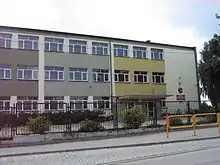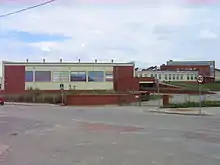Choroszcz
Choroszcz ([ˈxɔrɔʂt͡ʂ]) is a town in north-eastern Poland, located in Białystok County, Podlaskie Voivodeship, seat of Gmina Choroszcz.
Choroszcz | |
|---|---|
 Branicki Palace | |
 Flag  Coat of arms | |
 Choroszcz | |
| Coordinates: 53°8′N 22°59′E | |
| Country | |
| Voivodeship | Podlaskie |
| County | Białystok |
| Gmina | Choroszcz |
| Town rights | 1507 |
| Government | |
| • Mayor | Robert Wardziński |
| Area | |
| • Total | 16.79 km2 (6.48 sq mi) |
| Elevation | 130−175 m (500 ft) |
| Population (31 December 2021[1]) | |
| • Total | 5,960 |
| • Density | 350/km2 (920/sq mi) |
| Time zone | UTC+1 (CET) |
| • Summer (DST) | UTC+2 (CEST) |
| Postal code | 16-070 |
| Area code | +48 85 |
| Car plates | BIA |
| Highways | |
| Website | http://choroszcz.pl/ |
The Baroque palace in Choroszcz was the summer residence of the noble Branicki family, and is now part of the Museum of Polish Interiors. As of December 2021, the town has a population of 5,960.[1]
History

Choroszcz was granted town rights by King Sigismund I the Old in 1507. It was a private town, administratively located in the Podlaskie Voivodeship in the Lesser Poland Province. Jan Klemens Branicki erected a Baroque palace, which served as the summer residence of the Branicki family. Following the Third Partition of Poland, in 1795, it was annexed by Prussia. In 1807, it passed to the Russian Partition of Poland. Choroszcz was one of the sites of Russian executions of Polish insurgents during the January Uprising.[2] The execution sites are now marked by memorials.[3] Following World War I, Poland regained independence and control of the town.
In 1930, a psychiatric hospital was established in the town.[4]
Following the joint German-Soviet invasion of Poland, which started World War II in September 1939, the town was first occupied by the Soviet Union until 1941, and then by Germany until 1944. In 1940, the Russians closed the psychiatric hospital and deported some patients to the Soviet Union, while others were relocated to the local rectory.[4] In 1941, the Germans massacred several hundred remaining patients of the psychiatric hospital in today's Nowosiółki district as part of Aktion T4.[4]
After the war, it was administratively located in the "large" Białystok Voivodeship until 1975, and then the "small" Białystok Voivodeship until 1998.
Demographics


Detailed data as of 31 December 2021:[1]
| Description | All | Women | Men | |||
|---|---|---|---|---|---|---|
| Unit | person | percentage | person | percentage | person | percentage |
| Population | 5960 | 100 | 2979 | 50.0% | 2981 | 50.0% |
| Population density | 355.0 | 177.5 | 177.5 | |||
Choroszcz had 827 Jewish residents in 1897, and 450 in 1921. Nearly all were murdered in the Holocaust by the Germans during the Second World War.
Number of inhabitants by year
| Year | Population | Source |
|---|---|---|
| 1995 | 5132 |
[1] |
| 2000 | 5679 | |
| 2005 | 5424 | |
| 2010 | 5687 | |
| 2015 | 5789 | |
| 2020 | 5926 | |
| 2021 | 5960 |
Transport
Roads in Choroszcz:
 E67 Helsinki – Kaunas – Warsaw – Praga,
E67 Helsinki – Kaunas – Warsaw – Praga, S 8 Kudowa-Zdrój - Wrocław - Warsaw - Białystok - Suwałki - Budzisko,
S 8 Kudowa-Zdrój - Wrocław - Warsaw - Białystok - Suwałki - Budzisko,
Planned roads:
 S 19 - Białystok ring road
S 19 - Białystok ring road
Local transportation
For Choroszcz Take Bus 103 from the center of Białystok. Choroszcz is located 6 km from the borders of Bialystok. Cost of ticket:
-reduced (for students)
-1 zone : 1,40pln | ~0,35 €
-2 zone : 1,20pln | ~0,30 €
- 1+2 : 2,60pln | ~0,75 €
-normally
-1 zone : 2,80pln | ~0,65 €
-2 zone : 2,40pln | ~0,60 €
- 1+2 : 5,20pln | ~1,25 €
- Zone 1 - Białystok
- Zone 2 - Municipality Choroszcz
Education


- Kindergarten of Pope John Paul II
- Primary school of Henryk Sienkiewicz
- Public high school
Sport
The football club in Choroszcz it Narew Choroszcz occurring in the competition organized by the Podlaski Football Association - is the current Senior Class in the District. There are 3 teams that occur every day in the municipal league competitions: LZS Choroszcz, Choroszcz Rajkom and Lambada.
The main streets
- PL:Branickiego
- PL:Lipowa
- PL:Powstania Styczniowego EN - January Uprising
- PL:Henryka Sienkiewicza
- PL:Adam Mickiewicza
- PL:Aleja Niepodległości EN - Independence avenue
- PL:Ogrodowa
- PL:Dominikańska
Streets in Choroszcz
| Streets | Length in meters | Sidewalk in metres (left) | Sidewalk in metres (right) | Bike path in metres |
|---|---|---|---|---|
| 3-Maja | 910 (170m asphalt) | 170 | 170 | |
| Adama Mickiewicza | 2 150 | 2 150 | 540 | |
| Akacjowa | 310 | 310 | 310 | |
| Aleja Niepodległości | 950 | 50 | 200 | |
| Aleksandra Chodkiewicza | 170 | 170 | 170 | |
| Armii Krajowej | 150 | |||
| Batalionów Chłopskich | 195 | |||
| Białostocka | 1 450 | 505 | 505 | |
| Bobrowa | 395 | |||
| Brzozowa | 200 | 200 | 200 | |
| Chabrowa | 215 | |||
| Chmielna | 940 | |||
| Dominikańska | 360 | 360 | 360 | |
| Dzika | 335 | 80 | 80 | |
| gen. Zygmunta Berlinga | 150 | 150 | 150 | |
| Henryka Sienkiewicza | 840 | 840 | 840 | |
| Jana Klemensa Branickiego | 380 | 380 | 380 | |
| Józefa Ignacego Kraszewskiego | 140 | |||
| Józefa Piłsudskiego | 365 | 365 | 365 | |
| Juliusza Słowackiego | 200 | 200 | ||
| kard. Stefana Wyszyńskiego | 160 | 160 | 160 | |
| Klonowa | 105 | 105 | 105 | |
| Kolonia Gaj | 1 100 | |||
| Konwaliowa | 90 | |||
| Kościukowska | 1 700 (540m asphalt) | 90 | 540 | |
| Kruszewska | 1 780 (16 650 in gmina) | 1 780 (7 100 in gmina) | ||
| Krzysztofa Kamila Baczyńskiego | 220 | |||
| ks. Franciszka Pieściuka | 130 | 130 | 130 | |
| Legionowa | 215 | |||
| Leśna | 145 | |||
| Lipowa | 405 | 405 | 405 | |
| Lisia | 195 | |||
| Łąkowa | 245 | |||
| Mieczysława Sarosieka | 165 | |||
| Narwiańska | 205 | |||
| Ogrodowa | 669 | 550 | 119 | |
| Piaskowa | 1 150 | 450 | 450 | |
| Podleśna | 300 | 165 | ||
| Powstania Styczniowego | 576 | 576 | 576 | |
| Romualda Traugutta | 65 | |||
| Rumiankowa | 245 | |||
| Rybacka | 810 | |||
| Sarnia | 235 | |||
| Słoneczna | 315 | 315 | 315 | |
| Sosnowa | 55 | |||
| Spławikowa | 130 | |||
| Sportowa | 220 | 140 | 215 | |
| Stefana Mikołaja Paca | 340 | |||
| Stefana Żeromskiego | 80 | |||
| Szkolna | 155 | 155 | 155 | |
| Szpitalna | 210 | 210 | 210 | |
| Szyszkowizna | 490 | |||
| Świerkowa | 125 | 125 | 125 | |
| Tadeusza Kościuszki | 1 150 (450m pol-bruk) | 450 | 450 | |
| Torfowa | 695 | |||
| Tykocińska | 240 | |||
| Warszawska ( |
2 930 (11 085 in gmina) | 350 | 3 500 (11 750 in gmina) | |
| Wędkarska | 220 | |||
| Władysława Raginisa | 80 | 80 | 80 | |
| Wodociągowa | 140 | |||
| Zaczerlańska | 1 310 | |||
| Zamkowa | 120 | |||
| Zastawie I | 1 460 | 600 | ||
| Zastawie II | 1 420 | |||
| Zastawie III | 1 100 =2 300 | |||
| Żółtkowska | 1 110 (300m sett) | 140 | 100 | |
| Żwirowa | 380 |
| Gravel | Sett | Asphalt | concrete slabs |
References
- "Local Data Bank". Statistics Poland. Retrieved 2022-06-15. Data for territorial unit 2002014.
- Katalog miejsc pamięci powstania styczniowego w województwie podlaskim (in Polish). Białystok: Towarzystwo Opieki nad Zabytkami Oddział Białystok. 2013. p. 15.
- Katalog miejsc pamięci powstania styczniowego w województwie podlaskim, pp. 32–34
- Robert Fiłończuk. "Pacjentów zwieziono do lasu i tam rozstrzelano. Mord Niemców na pół tysiącu chorych psychicznie". Polska Agencja Prasowa (in Polish). Retrieved 26 December 2022.